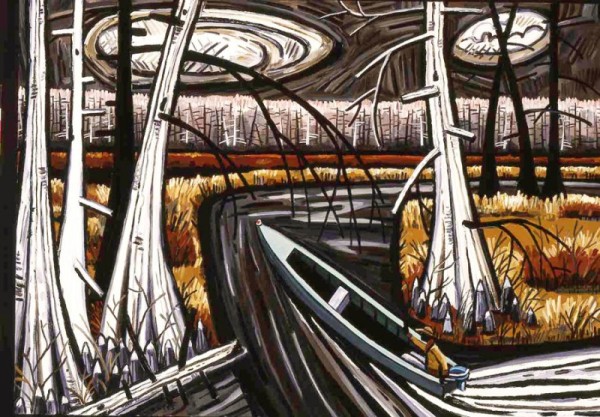Even something as flimsy as a trail of smoke cuts a voluptuous and commanding path across a David Bates canvas. A subtler artist couldn’t have pulled off this feat—dual retrospectives in dueling cities. Fort Worth’s incomparable Modern and Dallas’ Nasher Sculpture Center have joined forces to mount an in-depth exploration of Bates’ work, the former focusing on painting, and the latter on sculpture. Both exhibits are revelatory, and make the case for never having to visit New York again. Isn’t locally grown supposed to be better anyway?
I started at the Modern, where a surly portrait of a fisherman sizes up viewers at the top of the stairs. Bates’ oversized canvases are organized thematically, with pieces from as far back as the 1980s, unified by the artist’s unflinching paint application and his focus on regional life. Bates often works with a matte black or dark brown underpainting, troweling thick shapes of color atop to create dynamic contour lines. From afar, the effect is graphic; each segment of paint fits precisely into the next. The best examples of this were chosen for the exhibition’s “long views”— those moments between rooms when you happen to look up and a painting thirty feet away yanks you right back in.

The Deadening III
In The Deadening III, the black and white skeletons of trees in winter provide just such a pattern but, as with many of these pieces, the muscular mark making belies the nuance. Closer examination reveals a secondary palette of ochre-y rusts and teals that lets us feel the bite of the wind in a winter-stripped bayou.
Rather than creating impressions or fleeting moments, Bates cements his places and characters. Transitory pleasure or anguish becomes indelible through stylization. The gravitas of emotion is heightened by the precision of certain small details. In his Katrina portraits, the artist shows us the exact shade of cadmium red needed to describe a tear duct blown out from exhaustion and loss. Swoops of paint flesh out despair in a woman’s face. They are specific and iconic.

Self Portrait With Hat, 1998-99
Bates’ power wanes only when he delves too precociously into art historical tropes. In the exhibitions rearmost room are Bates’ Van Gogh sunflowers and Bates’ Picasso-like still lifes. There are self-portraits with varying degrees of self-indulgence.

Magnolia 2013
Interestingly, the vases of flowers that I find trite at the Modern are refreshing and humorous as sculpture at the Nasher. His floral sculptures jaggedly divide space. They are clunky and gorgeous in one swoop: even when cast in bronze, their Crayola-bright painted finishes keep them fresh. Magnolia Branch reveals the still-green interior rings of a freshly bisected limb.
The wittiness of these sculptures is their rickety appearance. Direct burnouts of cardboard and scrap wood make them feel spontaneous, but the craftsmanship required to make them look simple is daunting. The Nasher’s exhibit feels less cohesive than the Modern’s, but its stated intent (especially in the basement room) is a focus on the artist’s wide-ranging studio practice. In general, I have less desire to see how the “sausage is made,” understanding that masterful work like Bates’ doesn’t come from divine inspiration in the studio. His best works feel intuitive, almost accidental, because the accumulation of decades of experience has afforded him that leisure. It feels like a high-wire act; one wrong step might send the whole thing tumbling. But that is the wink. The cohesion of this body of work reveals an artist with unshakable trust in his subject matter and methods. Bates’ allows his viewer the breathless sense of risk without sacrificing a moment of control.



1 comment
It could not happen to a nicer guy. He is a serious artist that seems to be doing well.